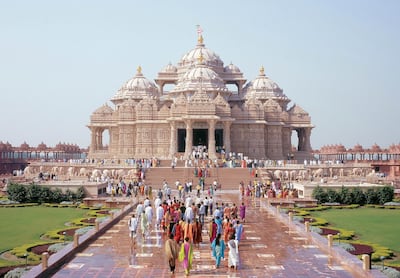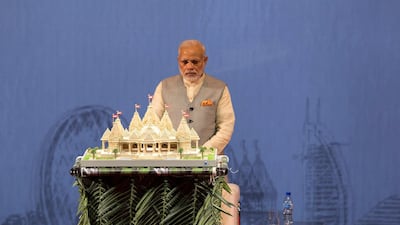The Middle East’s first traditional Hindu stone temple to be built in Abu Dhabi will feature intricate architecture and delicate carvings that will re-tell ancient stories from Indian scriptures about peace and spirituality.
Arches, pillars and domes interlaced with motifs of peacocks, elephants, trees and flowers will greet visitors.
This follows a universal theme depicting nature in other temples run by the BAPS Swaminarayan Sanstha, the non-profit organisation entrusted with constructing and managing the temple.
Panels of marble and stone will be handcrafted by artisans in Pindvada, Sikandra and other rural workshops in India’s Rajasthan state and later assembled in Abu Dhabi.
Sadhu Brahmavihari Das, chief spokesman of the sanstha or organisation, said the temple would be open to people of all beliefs and backgrounds, races and religions.
“This traditional temple will be a part of the UAE’s mission of happiness and harmony by helping to foster love, tolerance, understanding and peaceful coexistence,” he said.
A regular visitor to the Middle East, Mr Brahmavihari Das was part of the creative team that developed the sprawling Akshardham monuments that the sanstha is best known for in India’s Gandhinagar and New Delhi, and a smaller temple in Robbinsville, USA.
“It will facilitate the traditional practice of the Hindu faith and serve the over 3.3 million Indians residing in and the millions of international tourists annually visiting the UAE through interfaith dialogue, pluralism and universal human values,” he said.
The temple is expected to be constructed by 2020 in the capital’s Al Rahba area and will be modelled on other shrines built by the organisation, particularly the Akshardham temple in New Delhi.

While the Akshardham structures are expansive with pink sandstone walls encircling the complex, the Abu Dhabi temple will be much smaller in size.
Some designs are distinctive such as a Mayur Dwar or peacock gate, a feature of both the Delhi and Robbinsville temples.
Typically, the interior has carvings of Hindu deities and saints surrounded by ornate pillars with figurines of devotees playing small drums or classical string instruments like the sarod and sitar. Other sections are embellished with gold coloured metal sculptures of sages.
Models of elephants carting heavy logs of wood or picking up garlands of flowers is another characteristic design element with engravings that tell stories of wisdom and devotion.
“There is no machine work involved. Our temples are handcrafted. Each part has a story to tell like the elephant blocks. No matter what religion you are, no matter what your beliefs, you will enjoy peace,” said Alka Patel, a tour guide at the New Delhi temple.
Akshardham means eternal divine abode.
_______________
Read more:
Narendra Modi launches project to build Abu Dhabi's first Hindu stone temple
National Editorial: Landmark Hindu temple in Abu Dhabi is an emblem of tolerance
Hindu stone temple to be built in Abu Dhabi by 2020
_______________
The 1,200 temples in India, the UK, US, Canada, Africa and Australia handled by the organisation are crowd pullers with people coming to pray or simply gaze at ornate sculptures.
The temples also showcase Indian art and heritage with paintings of herbal dye recounting stories from Indian scriptures.
During a state visit to the UAE last week, Indian Prime Minister Narendra Modi said it would be a symbol of amity.
“I believe this temple will not only be unique in terms of architecture and beauty but will also give the message that the world is one family,” said Mr Modi during the temple launch when he thanked the rulers for granting the land and permission to build.
“It will be a holy place that will be a catalyst of humanity and harmony.”
The architecture will attract people of all faith, residents said.
“So many people will come in to Dubai to see the temple. It will promote interfaith dialogue and will show how inclusive the country is,” said Surender Kandhari, founder of the Sikh gurdwara in Dubai.
“By giving us land for the gurudwara and now for the temple, the UAE government has gone out of its way to support different faith.”
Those who have prayed at Swaminarayan temples in other countries are excited about a temple at their doorstep.
“It will give us even more of a feeling of home. Religion is close to people’s heart and this gives us more of a sense of belonging,” said Sonali Patel, a Dubai resident.
Volunteer with the sanstha and yoga teacher, Lina Rathore has been awaiting this for a long time. “We pray at home but for everyone to pray together, it brings a different kind of peace,” she said.
About Abu Dhabi's temple
The inauguration of the Abu Dhabi temple took place on February 11.
A two-hour long shila pujan or foundation stone laying prayer by sadhus, Indian holy men, marked religious sanction for construction to begin on the 55,000 square metre plot of land in Abu Dhabi's Al Rahba area.
Sheikh Mohammed bin Zayed, Crown Prince of Abu Dhabi and Deputy Supreme Commander of the Armed Forces gifted land and permission for the temple.
There are two temples, a gurudwara in Dubai and several churches across the emirates.
The Hindu temple will be the first for Abu Dhabi and the first traditional stone temple in the Middle East.
Plans were announced during Indian Prime Minister Narendra Modi’s visit to the UAE three years ago.
Abu Dhabi’s first temple will be designed, constructed and managed by the BAPS Swaminarayan Sanstha.
It is best known for the Akshardham shrines in Gandhinagar and New Delhi.
The 1,200 Swaminarayan shrines worldwide have interrelated features and the Abu Dhabi temple will embody messages of spirituality and peace.
Pillars depict embellished elephants, gates of peacocks and columns of musicians with traditional string instruments.
Carvings portray age-old tales advising people to stay away from greed and temptation.
Sculptures and paintings retell stories from folklore and Indian scriptures on wisdom, humility, leadership and teach how to block out negativity.
The model of the new temple unveiled in Dubai recently showed seven spires for the Emirates.
It also depicted water features and green areas enveloping the temple.
The compound will include a visitors’ centre, prayer halls, exhibitions, learning and play areas for children and thematic gardens.
It is expected to be completed by 2020.

